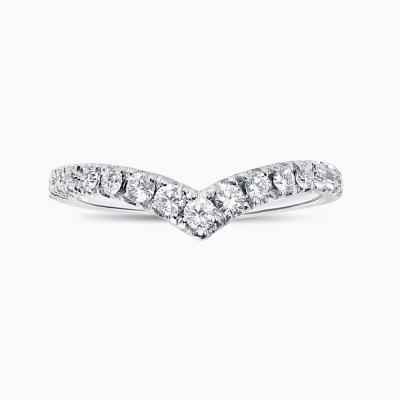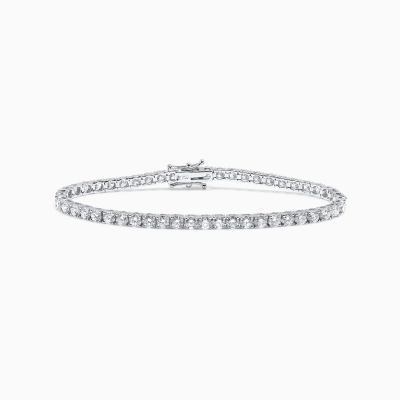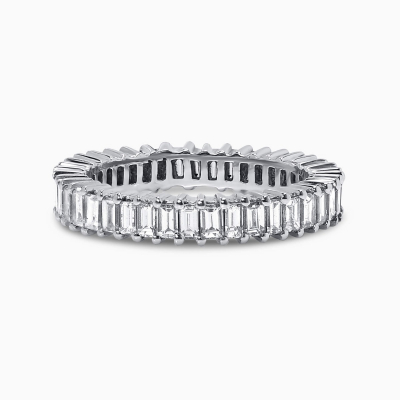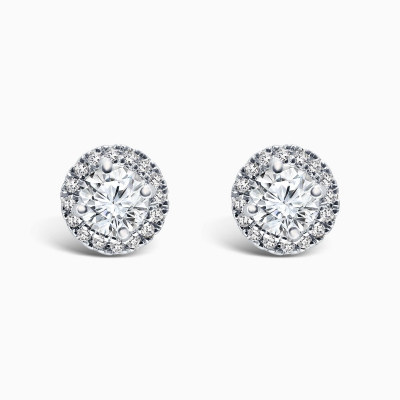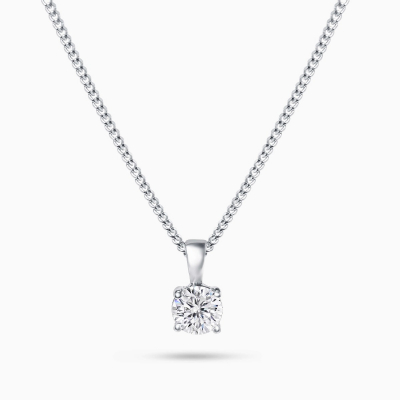USD
/
USD
/
Shipping to:
Currency:
- Wishlist
- Compare
- Contact Us
- NY +1 (646) 898 2098
- LA +1 (310) 920 6656
- Contact
- CALL NY
- CALL LA
-
Sign In
Sign In
- Create an Account
×
Speak to an expert
Get in touch with us using one of the options below:
-
Engagement rings
-
Wedding Bands
-
Jewelry
-
Gifts
-
GIFTS BY RECIPIENT
GIFTS BY OCCASION
GIFTS WITH MEANING
-
-
Diamonds
-
Diamonds Search
natural diamonds
Diamonds Search
Express insuredFree worldwide Delivery 3 to 7 Days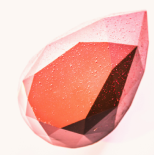
-
-
Gemstones
-
DESIGN YOUR OWN GEMSTONE RING
SHOP BY ORIGIN
Express insuredFree worldwide Delivery 3 to 7 Days
-
- Education
- Blog
18KT WHITE GOLD
White gold is an increasingly popular choice these days. Many women choose this color because, while it maintains the age-old tradition of a gold engagement ring, the metal's color has a more contemporary look than yellow gold. The purest form of gold is 24kt, but why opt for 18kt? Surely, the purer, the better for the lady in your life? In fact, 24kt gold is simply too soft for jewelry; it would scratch, tarnish, and dent quickly. Gold is usually combined with other metals to give it strength and resistance to cope with everyday life.
In the case of 18kt white gold, the ring is composed of 75% gold and 25% other metals. It is these alloys that give it its distinctive silver-white coloring. Alloys typically used include copper, zinc, and nickel, or in some instances, palladium and silver. It's worth noting, however, that some people may have an allergic reaction to nickel, so it's important to inform your jeweler if this applies to you when choosing a ring.
Whichever alloys are used, the final shank is then coated in a process called plating with rhodium. Although rhodium is a metal related to platinum, it is even tougher and tends to cost around four times more. Its value is reflected in the fact that it resists scratches and tarnishing, keeping your ring looking newer for longer. It also gives the white gold an additional reflective appearance, which will complement your diamond beautifully.
It's worth bearing in mind that the rhodium plating will wear off over time. However, it is not a big job for your jeweler to re-plate it for you, giving it that "good as new" appearance.
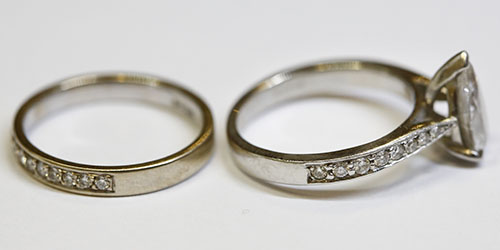
18kt White Gold Ring (left) vs Platinum Ring after one year of wear
White gold has become an increasingly popular choice for engagement rings and other fine jewelry, appealing to those who appreciate a modern twist on a timeless tradition. The allure of white gold lies in its sleek, contemporary look, which distinguishes it from the classic yellow gold, while still maintaining the prestige associated with gold jewelry.
Understanding White Gold Composition
White gold is typically made by blending pure gold with other metals to enhance its durability and achieve its distinctive color. Pure gold, known as 24kt, is inherently soft, making it unsuitable for jewelry that must withstand daily wear. As a result, gold is alloyed with metals such as copper, zinc, nickel, palladium, or silver, which not only add strength but also contribute to the final color of the metal.
In 18kt white gold, 75% of the composition is pure gold, while the remaining 25% consists of these other metals. This combination produces a strong, durable metal that can be crafted into exquisite pieces of jewelry. The choice of alloy can also influence the hue of the white gold, with palladium and silver creating a whiter finish compared to the warmer tones that nickel or copper might produce.
Rhodium Plating: Enhancing White Gold’s Beauty
To achieve the bright, reflective finish that white gold is known for, the jewelry is often plated with rhodium, a rare metal from the platinum family. Rhodium is highly valued for its exceptional hardness and resistance to scratches and tarnishing. This plating not only enhances the whiteness of the gold but also adds an extra layer of protection to the jewelry, ensuring it retains its luster over time.
However, it's important to note that rhodium plating is not permanent. Over time, the plating may wear off, especially in pieces that are worn frequently, such as rings. Fortunately, re-plating is a relatively simple process that can restore your jewelry to its original brilliance.
FAQs About White Gold
What is the difference between white gold and platinum?
- White gold is an alloy made primarily of gold mixed with other metals, then plated with rhodium to achieve its color. Platinum, on the other hand, is a naturally white metal that does not require plating. Platinum is denser and more expensive than white gold but also more durable and hypoallergenic.
Is white gold more expensive than yellow gold?
- The cost of white gold and yellow gold is generally similar, as the value primarily depends on the gold content (e.g., 18kt vs. 14kt). However, the additional cost of rhodium plating can make white gold slightly more expensive.
How often does white gold need to be re-plated?
- The frequency of re-plating depends on how often the jewelry is worn. Typically, rings may need re-plating every 1 to 3 years, while earrings or pendants may last longer before re-plating is necessary.
Can white gold cause allergies?
- Some people may experience allergic reactions to the nickel in white gold alloys. If you have a known nickel allergy, it’s advisable to choose white gold made with palladium or silver alloys instead or opt for hypoallergenic metals like platinum.
How should I care for my white gold jewelry?
- To maintain the appearance of your white gold jewelry, avoid exposing it to harsh chemicals, such as chlorine or household cleaners, which can damage the rhodium plating. Regularly clean your jewelry with a mild soap and water solution, and store it separately from other pieces to prevent scratches.
Is white gold a good choice for engagement rings?
- White gold is an excellent choice for engagement rings due to its modern appearance and durability. It complements diamonds and other gemstones beautifully, offering a timeless yet contemporary look. Just be aware of the need for occasional re-plating to maintain its luster.
Can I resize a white gold ring?
- Yes, white gold rings can be resized, but the process may require re-plating with rhodium afterward to ensure a consistent appearance. Always consult a professional jeweler to perform resizing to avoid damaging the ring.
Does white gold tarnish?
- While the gold alloy itself does not tarnish, the rhodium plating can wear away over time, which might make the jewelry look dull or slightly yellow. Regular re-plating can prevent this and keep your jewelry looking bright and shiny.
How does white gold compare to other metals in terms of durability?
- White gold is more durable than pure gold due to the alloying process but less durable than platinum. It offers a good balance between beauty and strength, making it suitable for everyday wear.
By understanding the composition, care, and common concerns associated with white gold, you can make an informed decision when choosing this beautiful metal for your jewelry. Whether for an engagement ring, wedding band, or other special pieces, white gold continues to be a favored choice for its elegance and modern appeal.
- Carat
- Platinum
- 18kt White Gold
- 18kt Yellow Gold
- 18kt Rose Gold
- Welsh Gold
- Two Metals Band
- Prong Setting - Diamond Solitaire Rings
- The Tiffany Setting
- Cartier Engagement Rings
- De Beers Engagement Ring
- Halo Setting
- Double Halo Setting
- Twist Setting
- Bezel Setting
- Tension Setting
- Flush Setting
- Compass Setting
- Three Stone Setting – Trilogy
- Cluster Setting
- Antique-Vintage Setting
- Edwardian Engagement Rings
- Victorian Engagement Rings
- Art Deco Engagement Rings
- Salt and pepper diamond Rings
EXPLORE OUR COLLECTIONS
item(s) in your cart







